Temperature extremes cause diseases of numerous foliage and flowering plants. Low temperatures have been identified as the cause of more problems than high temperatures. Sensitivity to low temperatures is probably due to the tropical or subtropical origins of many plants.
High Temperature
|
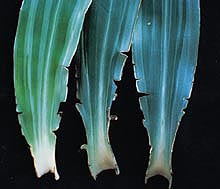
Fig. 2. Notching of Dracaena deremensis 'Warneckii.' From the Compendium of Ornamental Foliage Plant Diseases.
|
Apical necrosis caused by rapid increases in temperature in foliage plants was first described in 1961. The tested plants were not damaged at 15.5 or 35ºC (60 or 95ºF), but raising the temperature from 15.5ºC to 35ºC resulted in apical necrosis or blackening of new leaves. The most sensitive plants were Monstera deliciosa Liebm. (Swiss cheese plant), Philodendron hastatum C. Koch & H. Sello, Ficus elastica Roxb. ex Hornem. (India-rubber tree), and Dracaena fragrans (L.) Ker-Gawl. 'Massangeana' (corn plant). Apical necrosis did not develop on Dieffenbachia picta Schott and Dracaena deremensis Engl. 'Warneckii' under these conditions. Sudden fluctuations of temperatures should be avoided, especially in unrooted cuttings of sensitive plants.
D. deremensis 'Warneckii' is subject to notching, a condition affecting marginal tissue near the leaf base (Fig. 2). This condition is apparently due to high temperatures.
A combination of stomatal exudation and high temperatures was determined to be the cause a leaf spot of P. hastatum, reported in California in 1957. Discrete lesions, usually less than 2 mm in diameter, formed randomly over the lower surface of leaves. The lesions were sometimes numerous on older leaves and were covered with a sticky, colorless exudate. This disease was most severe at high temperatures, and soil temperature affected disease severity as well.
Low Temperature
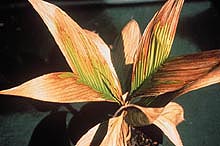
Fig. 3. Cold damage on Geonoma sp.
(Click image for expanded view).
|
|
Cold or cool environments can severely damage tropical plants (Figs. 3-5). Temperatures that are safe for many other crops cause chilling injury in some foliage plants. One of the first plants identified as sensitive to cold was Sansevieria trifasciata Prain (syn. S. laurentii de Wild., snake plant). Exposure to temperatures of 2-8ºC results in the development of white, sunken, irregularly shaped lesions up to 1 month later. Cold injury of Sansevieria is more severe in plants receiving high levels of nitrogen and potassium than in plants receiving lower levels of these nutrients.
|
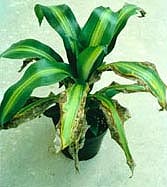
|
|
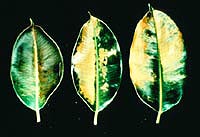
|
|
|
Fig. 4. Cold damage on Dracaena massangeana. From Foliage Plant Diseases: Diagnosis and Control. |
|
Fig. 5. Frost injury on Ficus elastica. From Foliage Plant Diseases: Diagnosis and Control.
|
|
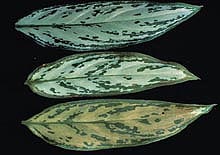
Fig. 6. Leaves of Aglaonema commutatum 'Silver Queen' with marginal water-soaking and chlorosis caused by exposure to chilling at 10°C (center) and 5°C (bottom) for 24 hr, with an untreated leaf (top). (Click image for expanded view).
|
|
Another typical example of chilling injury occurs in Aglaonema spp. A. commutatum Schott 'Silver Queen' is especially sensitive to chilling at temperatures below 10ºC (50ºF). The symptoms are characteristically greasy-looking, water-soaked lesions (Fig. 6), developing within 48 hours of exposure and affecting old leaves most severely. The development of chilling-resistant cultivars of Aglaonema has been proposed, since some members of this genus are significantly more tolerant of chilling than Silver Queen is. Other chilling sensitive plants are A. nitidurn (Jack) Kunth 'Curtisii,' A. commutatum var. picturatum 'Treubii,' and A. commutatum 'Fransher.' Other foliage plants that have been tested for sensitivity to chilling are listed in Table 32 of the Compendium of Ornamental Foliage Plant Diseases.
Chilling injury can also occur during shipment of plants (Fig. 7). F. benjamina L. (weeping fig) is fairly tolerant of cold, but heavy leaf abscission occurs and some terminal shoots die after chilling damage. Container-grown plants cannot be shipped at temperatures of 7ºC (45ºF) or below for periods of 2 weeks or more. Chilling damage may also occur when plants are grown in the summer and shipped at 10ºC (50ºF) for 4 weeks.
|
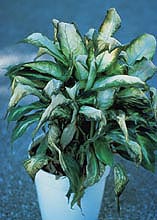
Fig. 7. Severe cold damage on Dieffenbachia maculata shipped at 35°C (Courtesy J. M. F. Yuen).
(Click image for expanded view).
|
|
Selected References
Conover, C. A., and Poole, R. T. 1973. Factors influencing notching and necrosis of Dracaena deremensis 'Warneckii' foliage. Proc. Am. Soc. Hortic. Sci., Trop. Reg. 17:378-384.
Conover, C. A., and Poole, R. T. 1983. Chilling injury of Ficus benjamina during simulated shipping. Agric. Res. Cent., Apopka, Res. Rep. RH-83-25.
Elliot, F. H. 1946. Saintpaulia leaf spot and temperature differential. Proc. Am. Soc. Hortic. Sci. 47:511-514.
Fooshee, W. C., and McConnell, D. B. 1980. The effect of chilling on subsequent rooting of Aglaonema 'Silver Queen' tip cuttings. Proc. Fla. State Hortic. Soc. 93:212-213.
Graham, S. 0. 1961. Apical necrosis in ornamental foliage plants caused by rapid temperature changes. Plant Dis. Rep. 45:41.
Hummel, R. L., and Henny, R. J. 1986. Variation in sensitivity to chilling injury within the genus Aglaonema. HortScience 21(2):291-293.
Hummel, R. L., and Johnson, C. R. 1985. Freezing tolerance in the genus Ficus. HortScience 20(2):287-289.
Marlatt, R. B. 1974. Chilling injury in Sansevieria. HortScience 9(6):539-540.
Marousky, F. J. 1980. Chilling injury in Dracaena sanderana and Spathiphyllum 'Clevelandii.' HortScience 15(2):197-198.
McConnell, D. B., Ingram, D. L., Groga-Bada, C., and Sheehan, T. J. 1982. Chilling injury of silvernerve plant. HortScience 17(5):819-820.
McWilliams, E. L., and Smith, C. W. 1978. Chilling injury in Scindapsus pictus, Aphelandra squarrosa and Maranta leuconeura. HortScience 13(2):179-180.
Munnecke, D. E., and Chandler, P. A. 1957. A leaf spot of Philodendron related to stomatal exudation and to temperature. Phytopathology 47:299-303.
RETURN TO APSnet FEATURE STORY
